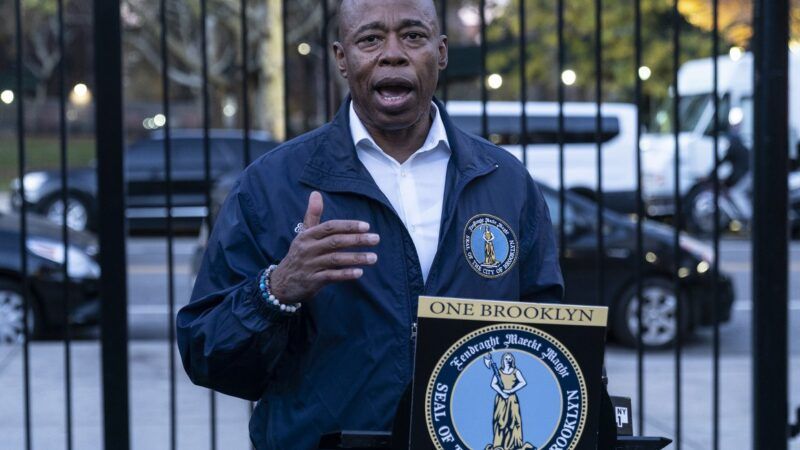Incoming New York Mayor Makes Vague Case for the 'Proper' Kind of Stop-and-Frisk
Eric Adams thinks he can give the police more power to hunt for guns without making innocent minority men the inevitable target.

Writing in the Daily News, New York Mayor-elect Eric Adams is vaguely promising a kinder, gentler "stop and frisk" policing.
On the campaign trail, Adams had said that he didn't fully oppose the concept of "stop and frisk"—the police practice stopping people with very little suspicion to make sure they aren't carrying guns or drugs—but that he believed the New York Police Department (NYPD) had abused its authority with the mass targeting of minorities for searches. He agreed that the police had implemented "stop and frisk" in an illegal way, but he didn't think the practice itself was entirely bad.
So how does he think it should work instead? In his Daily News article, Adams discusses an incident last week when two officers in the Bronx were shot by a suspect while they responded to a 911 call about a suspicious man with a gun. According to the NYPD, the officers approached a man matching the description they received and asked him to show his hands. The man, 23-year-old Charlie Vasquez, reportedly produced a gun and shot at the officers.
Adams' conclusion:
The threat was neutralized. One more gun off the street. One more blow against the bad guys.
Yet there are some in our city who would say these officers should never have confronted Vasquez, that he never should have been stopped and questioned.
This is quite the straw man argument. Let's unpack it. These two officers did not, in fact, engage in any sort of "stop and frisk" at all. They approached a man who matched a description of somebody reportedly walking around with a gun. Before the officers were in a position to determine whether he was a suspect or even to question him, the man shot at them.
Adams doesn't indicate who, precisely, thinks the police shouldn't have confronted or questioned Vasquez. Perhaps that's because this wasn't the objection to "stop and frisk."
This is thoroughly uncontroversial policing. (Or most of it is. One of the officers might have accidentally shot the other during the confrontation.) Most people across the political spectrum want the cops to investigate a potentially dangerous person who may be up to criminal activity. The problem, as Adams well knows, is what the police actually end up doing. This isn't what "stop and frisk" looked like in New York City at all.
It is true, as Adams notes in his opinion piece, that the courts have recognized the police power to stop and search people if they have a reasonable suspicion that said person is suspected of a crime and they believe he is armed. But in New York City, "stop and frisk" actually resulted in hundreds of thousands of annual searches of predominantly minority men who it turned out were not armed and ended up not being arrested. In a 2014 report by the New York Civil Liberties Union, only two percent of police encounters under "stop and frisk" ever uncovered weapons. At the policy's height, NYPD officers were stopping nearly 700,000 people a year.
So why on earth is Adams attempting to use a case where a man was not even frisked—a case where the guy actually shot at police—as an example of some sort of "proper" stop and frisk? Because it's all about the guns. Adams, just like former Mayor Michael Bloomberg, is big on gun control. He is attempting to convince New Yorkers that some form of stop-and-frisk policy will be needed to keep the community safe from armed criminals.
It is unclear exactly what change Adams thinks will give the NYPD this power without returning the city to the level of abuse that Adams himself used to oppose. (His opposition to the status quo was real—when he was a state senator, he helped craft a law that purged NYPD database of the names of innocent people they searched.) Instead we get a vague theoretical defense of stopping and frisking people in some proper way, resting on an example that doesn't meet the normal definition of "stop and frisk." Adams fails to ask how the police might behave when they approach someone who turns out to be innocent.


Show Comments (50)